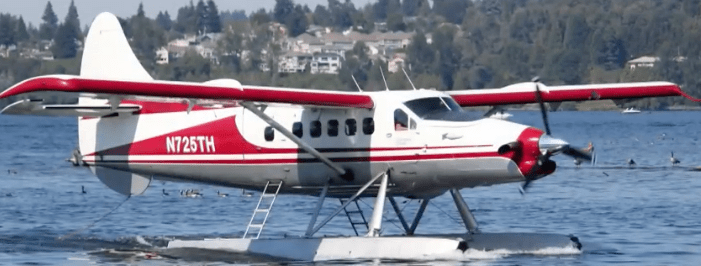Whidbey Island (Washington) plane crash was very likely a “vaxxident,” and now the most deadly so far during The Great Reset
TheCOVIDBlog.com
September 9, 2022 (updated *September 10, 2022 – 6:00 p.m. Pacific. See below)

WHIDBEY ISLAND, WASHINGTON — We want to emphasize that there is no definitive proof that the pilot of this plane was “vaccinated.” The company that operated the plane, however, frequently flies into Canada. All flight crews, pilots, truckers, passengers, etc. have been required to be fully vaccinatedto travel in and out of Canada since January. Twelve of this particular plane’s final 29 flights went to Canada or originated in Canada (return trips).
Based on what’s unfolded so far since the Sunday, September 4 plane crash in the Puget Sound, all anyone, including the National Transportation Safety Board (NTSB), can and will be able to do is speculate as to what happened. Thus we have the right and the journalistic background to do so as well.
The de Havilland DHC-3 Otter float plane
The plane involved in this accident is tail number N725TH. It is a 1967 de Havilland DHC-3 fixed-wing, single engine “Otter” aircraft, according to Federal Aviation Administration (FAA) data.

It was manufactured from 1951 to 1967. There were 466 of these planes produced in total.The crashed DHC-3 Otter had serial number 466, meaning it was the last and “newest” one produced. It is a short take off and landing (STOL) plane; it doesn’t need a lot of runway or water to take off and/or land.
This specific plane was used mostly for short flights. It took a total of 29 flights from August 26 until the crash. Only 10 of those flights lasted more than one hour. Its last voyage was the sixth flight of the day for this plane, according to FlightAware data. The plane was owned by Northwest Seaplanes Inc. and operated by Friday Harbor Seaplanes.
It was a 55-year-old aircraft. That doesn’t necessarily mean the plane is “bad,” if you will. Its airworthiness certificate was issued on May 12, 2014.

All airplanes must pass annual inspections to operate. Northwest Seaplanes posted a Facebook video last November prepping N725TH for its annual maintenance check.

The U.S. military was once de Havilland’s biggest customer. Militaries around the world have used these planes for rescue operations and to drop supplies in hard-to-reach areas for decades. There are still 68 of said planes registered with the FAA today. One report said there were 117 DHC-3 Otters registered in Canada in 2017.
RELATED: Dr. Sugata Das: disturbing cockpit video shows last moments of cardiologist’s life before he crashed his private plane near San Diego, killing one other person (October 28, 2021)
The DHC-3 Otter has a maximum capacity of 12 people, which can break down to two pilots and 10 passengers, or one pilot and 11 passengers. Thus the Whidbey Island flight was at full capacity. These planes can be configured with amphibious floats, standard wheels, or skis for landing on snow. In other words, they are meant to handle unusual terrain.
It’s unclear if the floats on N725TH were amphibious, meaning they also had wheels for potential landings on runways. Regardless, all reports refer to it as a “float plane” built to land on water.
From 900 feet to impact in five seconds, no mayday
The flight took off from Friday Harbor on San Juan Island (pinned below), Washington at 2:50 p.m. Pacific time. It was headed to Renton, Washington, about 12 miles south of Seattle.

It’s an 80-mile flight, about 40 minutes in the air. Note it’s about a four-hour drive from Friday Harbor to Renton (due to all the tolls and bridges) despite being only 115 miles of actual road. Ten of this plane’s last 29 flights were this same trip from Friday Harbor to Renton or vice versa. They all averaged about 38 total minutes in flight time.
What we know for certain is that there was no mayday (distress call) to air traffic control, according to several sources. Witnesses who saw the crash told The Seattle Times that at first, they thought the plane was landing (on water). “But it was coming in at a 45-degree angle,” one witness said. All accounts of the crash described a “huge splash,” a loud noise, then the plane completely disappearing underwater near Whidbey Island in Mutiny Bay (Puget Sound) at about 3:08 p.m. local time.
Reports indicate that the plane was just fine for the first 18 minutes of the flight. The Automatic Dependent Surveillance–Broadcast (ADS-B) data for the flight show that the plane was cruising at 900 feet from 3:08:00 p.m. to 3:08:48 p.m. It plunged to 800 feet at 3:08:50 p.m., then to 200 feet just three second later. It was off the radar thereafter. In other words the plane plunged at cruising speed from 900 feet in the air, into the water (that is 250-300 feet deep) nose-first in less than five seconds.

RELATED: U.S. motor vehicle traffic fatalities in 2021 break record for largest annual percentage increase in recorded history (May 25, 2022)
The Times spoke to Ms. Kathleen Bangs, a pilot and spokeswoman for FlightAware. She emphasized that she’s only offering her opinion. But Ms. Bangs first stated the obvious – even with engine failure, the pilot could glide a float plane down safety into the water. Ms. Bangs then offered the following:
“When you see something like that, you think, ‘Could it have been a collision with something, could it have been pilot incapacitation, or could it have been intentional?’ Once you get those out of the way, the thing I’d be looking at is the age of the airplane.”
There are reports that the plane’s owner was on another flight right behind N725TH. He told media outlets that the plane looked like it was headed slightly off course in the moments before the crash.
The victims
There were 10 people, including the pilot, aboard the plane. All of them are presumed dead. Only one body has been recovered from the water. Civilian rescuers found the body of Ms. Gabrielle Hanna, 29, shortly after the crash.

Ms. Hanna, pictured above, was a lawyer at Cooley Law Firm in Seattle.

The pilot was Mr. Jason Winters (pictured above). Very little information is being reported about him – not even his age. The only Jason Winters in Washington listed in the FAA database says he received his commercial pilot certificate in September 2019. Northwest Seaplanes said via Instagram that he’d been flying since 1995. A GoFundMe page says Mr. Winters had a wife and “children.”
Mr. Ross Mickel, his eight-months pregnant wife Ms. Lauren Hilty, and their 22-month-old son Remy Mickel were also aboard, and presumed dead. Mr. Mickel was the founder of Ross Andrew Winery. Ms. Hilty is the sister of Broadway actress Megan Hilty. She posted about the crash via Instagram.


The couple had another daughter too. Megan Hilty said via Instagram, “Lauren and Ross left behind my niece who we are all holding in our hearts. Thankfully, she was not on the plane.” Megan also said that unborn Luca was the 11th victim.

Mr. and Mrs. Luke and Rebecca Ludwig(pictured above) were also on the plane. The couple, both 42 years old, lived in Shorewood, Minnesota – about 20 miles west of Minneapolis. They reportedly had children. But details are scant.

Mrs. Joanne Mera, 60 (pictured above), was the CEO of Pacific Event Productions in San Diego. She is survived by her husband and three children.

Ms. Patricia Hicks, 66 (front), and Ms. Sandy Williams, 61, were “partners,” according to the Spokesman-Review. Both lived in Spokane. Ms. Hicks was a retired teacher, while Ms. Williams was executive director of the nonprofit Carl Maxey Center. She also helped found the EWU Pride Center. The two were reportedly celebrating Ms. Williams’s birthday before the flight.
So what’s the verdict?
Again, all we can do is speculate. The active search for both the plane wreckage and bodies was called off on Monday, September 5. The Coast Guard searched 2,100 square nautical miles, to no avail. The NTSB is conducting the investigation. The National Oceanic and Atmospheric Administration and the Washington Department of Fish and Wildlife are assisting in the search efforts. None of the plane’s wreckage had been found as of publishing. All that’s turned up so far are some personal belonging of the passengers, a seat cushion, and some papers.
The remaining bodies are likely already gone – eaten or decomposed. The Puget Sound salt water is corroding the metal parts of the plane. Bottom line is that any conclusion reached by the NTSB will be a guess on the #ABV spectrum. We’re entitled to speculate as well.
When someone spontaneously drops dead from the injections, it’s typically from a ruptured brain aneurysm or cardiac arrest. And it’s very sudden. Some examples caught on video include Saudi businessman Mr. Mohammed bin Nasser bin Wazan Al-Qahtani, Pakistan cop Mr. Malik Imtiaz Mahmood, and Indian singer Mr. Evada Basheer. Others, such as actress Ms. Heather McDonald, British television presenter Ms. Kate McCann, and the infamous Ms. Tiffany Dover, all (initially) survived after losing consciousness on camera.
The only thing that prevented the proverbial loud thud to the ground with Ms. Dover was all the people around her to stop it.
RELATED: Mayday: Four helicopters, seven private planes crash in United States in 14 days, at least 20 people dead (February 28, 2022)
When you press the yoke (“steering wheel”) forward on an airplane, it tips the nose down and brings the tail up. All eyewitness accounts say the plane went into the water nose first. The plane dropped from 900 feet to impact with the water in five seconds. Even if a bird or drone hit the plane, it’s not going to drop that fast at that angle. If planes were that fragile, there would be 50 plane crashes per day without “vaccines.” The plane would still glide for a while in the case of engine failure, not drop from 900 feet to impact in five seconds.
The only realistic cause of this crash was someone deliberately or otherwise pushing the yoke forward as hard as possible while the plane was traveling well over 100 mph. This blogger is neither a pilot nor an expert on airplanes. He has, however, watched several of those MayDay Wonder videos once all these unusual plane crashes started happening during The Great Reset. Said documentaries are interesting educations on air traffic terminology, basics of airplane mechanical operations, and what happens during a plane crash.
What this blogger is well-versed in, however, is post-injection deaths and how/why they occur. Our educated guess is that the pilot went into cardiac arrest or suffered a ruptured brain aneurysm, lost consciousness, slumped all of his weight forward on the yoke, and sent the plane straight into the water, nose first. Granted 900 feet isn’t that high up. But that’s still one-fifth of a mile covered in five seconds. There’s literally nothing else that could cause a small plane to nosedive that fast into the water.
RELATED: Mainstream media focus on “hero passenger” Darren Harrison landing plane in Florida, while completely whitewashing the suddenly incapacitated pilot (May 13, 2022)
Some of those Wonder videos show pilots gliding large commercial jets with failed engines or other failed components, down to the surface of water for emergency landings. Nearly all of those “landings” ripped the planes apart just from gliding on the water’s surface. But this DHC-3 Otter could have easily been glided down by an experienced pilot, and landed safely in water in the event of engine or some other mechanical failure.
Most bird strikes do not cause crashes. They may kill the engine. But again, this particular plane is meant to glide and land on water. Further, a dead engine is not going to cause an airplane, even a single-engine one, to plummet from 900 feet to the water in five seconds. The speed at which this plane impacted the water means very little is likely left in large pieces.
The previous deadliest plane crash that points to “vaxxident” killed eight people. This one killed 10 plus one unborn. Boarding a plane at all in 2022 is foolish. Boarding a plane with only one pilot is a death wish. Stay vigilant and protect your friends and loved ones.
UPDATE September 10, 2022 6:00 p.m. Pacific – This article set some people off
The COVID Blog™ moderators forwarded four comments citing an article published today by Aviation Law Group in Seattle about this crash. The crux of all these comments cite this part of the Aviation Law Group article:
“On June 20, 1989, DHC-3 Otter N41755 unexpectedly pitched nose down when the horizontal stabilizer jack-screw failed in flight. The cause was determined to be improper lubrication and excessive wear.”
The article goes on to compare the foregoing incident to Alaska Airline Flight 261. It involved a McDonnell-Douglas MD-83 commercial jet that crash-landed into the Pacific Ocean.

The January 31, 2000 incident killed all 88 people onboard. This also happened to be the first #MayDay Wonder video this blogger watched last year. This campaign is obviously building up to an #ABV disposition from the NTSB, in regards to the September 4 crash.
The June 20, 1989 N41755 DHC-03 Otter “issue” was a hiccup. The pilot “landed safely by exerting a large amount of back pressure on the control wheel and adding nearly full engine power.” In other words, he pulled the yoke backwards to correct the issue. No damage was sustained in the landing. Conveniently these facts are omitted from the foregoing article.
N41755 was sold a couple months later and put right back into service. It actually got into another accident on July 22, 1992. The NTSB determined that an engine fire caused the crash. DHC-3 Otter N41755 sat around for over a decade until 2005 when Harbour Air in Vancouver bought it and repaired it. It was registered as “C-FHAX” with the Canadian Aircraft Registry in 2006. The plane is still in service today.
Comparing what is basically the equivalent of a flat tire on a car traveling 40 mph, to a tragedy that killed 88 people, and another tragedy that killed 11 people, is low-effort propaganda and deflection. We’re not going to allow that on this blog.


No comments:
Post a Comment